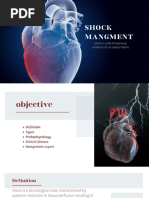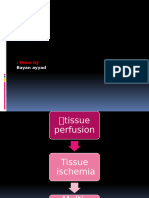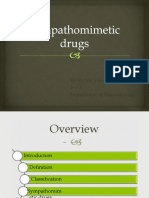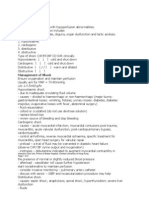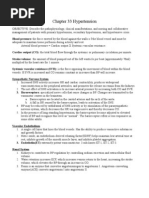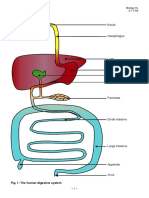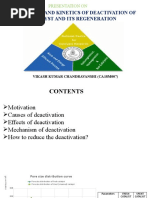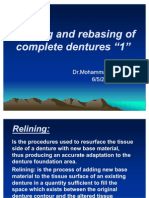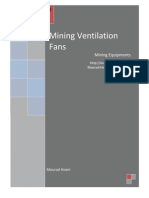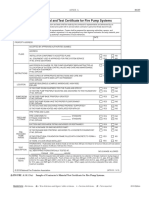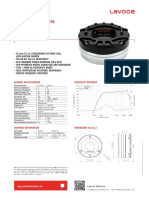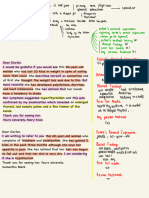0 ratings0% found this document useful (0 votes)
14 viewsDrugs For Shock
Drugs For Shock
Uploaded by
renz bartolomeThis document discusses various drugs used to treat shock, including fluid replacement agents, vasoconstrictors/vasopressors, inotropic agents, and drugs for anaphylaxis. Shock occurs when vital organs do not receive enough blood flow and can be caused by trauma, bleeding, burns, infection, or severe allergic reaction. Treatment focuses on restoring blood volume and pressure through intravenous fluids, blood products, vasopressors, or inotropic drugs to increase cardiac output, with epinephrine as the primary treatment for anaphylactic shock. Nursing care involves close monitoring of vital signs, urine output, and neurological status.
Copyright:
© All Rights Reserved
Available Formats
Download as PDF, TXT or read online from Scribd
Drugs For Shock
Drugs For Shock
Uploaded by
renz bartolome0 ratings0% found this document useful (0 votes)
14 views3 pagesThis document discusses various drugs used to treat shock, including fluid replacement agents, vasoconstrictors/vasopressors, inotropic agents, and drugs for anaphylaxis. Shock occurs when vital organs do not receive enough blood flow and can be caused by trauma, bleeding, burns, infection, or severe allergic reaction. Treatment focuses on restoring blood volume and pressure through intravenous fluids, blood products, vasopressors, or inotropic drugs to increase cardiac output, with epinephrine as the primary treatment for anaphylactic shock. Nursing care involves close monitoring of vital signs, urine output, and neurological status.
Original Title
Drugs for Shock
Copyright
© © All Rights Reserved
Available Formats
PDF, TXT or read online from Scribd
Share this document
Did you find this document useful?
Is this content inappropriate?
This document discusses various drugs used to treat shock, including fluid replacement agents, vasoconstrictors/vasopressors, inotropic agents, and drugs for anaphylaxis. Shock occurs when vital organs do not receive enough blood flow and can be caused by trauma, bleeding, burns, infection, or severe allergic reaction. Treatment focuses on restoring blood volume and pressure through intravenous fluids, blood products, vasopressors, or inotropic drugs to increase cardiac output, with epinephrine as the primary treatment for anaphylactic shock. Nursing care involves close monitoring of vital signs, urine output, and neurological status.
Copyright:
© All Rights Reserved
Available Formats
Download as PDF, TXT or read online from Scribd
Download as pdf or txt
0 ratings0% found this document useful (0 votes)
14 views3 pagesDrugs For Shock
Drugs For Shock
Uploaded by
renz bartolomeThis document discusses various drugs used to treat shock, including fluid replacement agents, vasoconstrictors/vasopressors, inotropic agents, and drugs for anaphylaxis. Shock occurs when vital organs do not receive enough blood flow and can be caused by trauma, bleeding, burns, infection, or severe allergic reaction. Treatment focuses on restoring blood volume and pressure through intravenous fluids, blood products, vasopressors, or inotropic drugs to increase cardiac output, with epinephrine as the primary treatment for anaphylactic shock. Nursing care involves close monitoring of vital signs, urine output, and neurological status.
Copyright:
© All Rights Reserved
Available Formats
Download as PDF, TXT or read online from Scribd
Download as pdf or txt
You are on page 1of 3
Drugs for Shock Causes: trauma or bleeding,
Fluid Replacement Agents a. Hypovolemic (volume depletion) hemorrhage,
Blood and blood Products extensive burns, DHN, vomit and diarrhea.
Crystalloid Solutions : normal serum albumin b. Neurogenic shock: sudden loss of nerve impulse
(Albuminar, Albutein) communication
Vasoconstrictors/ Vasopressors: norepinephrine c. Cardiogenic shock: inadequate CO due to pump
(Levarterenol, Levophed) failure • Septic shock: presence of bacteria and
Inotropic Agents: dopamine (Dopastat, Inotropin) toxins in the blood.
Drugs for Anaphylaxis: epinephrine (Adrenalin) d. Anaphylactic shock: food or drug intake, most
severe type I allergic response
SHOCK
- wherein the vital tissues and organs are not TREATMENT:
receiving enough blood to function properly. - The goal is to maintain BLS basic life support
- Without adequate oxygen, cells cannot carry out ABC, to restore normal fluid volume and
metabolic processes composition and maintain adequate BP.
- It is considered as medical emergency and may - Connect to cardiac monitor and pulse oximeter
lead to irreversible organ damage and death - BP readings on the opposite of pulse oximeter as
- Thirst is a common complaint, skin may feel cold peripheral vasoconstriction with the inflation of BP
or clammy. cuff.
- Inability of the cardiovascular system to send - Oxygen at 15L/min via a nonrebreather mask.
sufficient blood to the vital signs: heart and brain - LOC and neurological status are monitored.
- - Quiet and warm psychological support and
Cardiovascular: BP low, CO diminished, HR may be reassurance
rapid with weak thread pulse a. Anaphylaxis
Respiratory: Breathing is rapid and shallow - to prevent or stop the hypersensitive inflammatory
Metabolism: Low temperature, thirst, acidosis, low urine response
output b. Fluid Replacement Agents
Neurologic: restless, anxious, lethargic, confusion - blood, blood products, colloids and crystalloids.
c. Treating Shock with IV infusion therapy: Nursing Considerations
- Whole blood, plasma proteins, fresh frozen - Monitor clients condition provide education as it
plasma and globulins. properly typed and cross relates to the prescribed drug treatment. Monitor
matched mental status, skin temp, ear lobes color, nail beds
- Whole blood thou being carefully screened has the and lips.
potential to transmit serious infections (hepatitis or - Assess BP and HR
HIV) - History for CV disease ( vasoconstrictors are
contraindicated in severe CV disease)
COLLOIDS (PROTEINS AND CRYSTALLOIDS) - Obtain ECG reading, monitor chest pain (reduce
- Infusions are often used when up to 1/3 of adults dosage if HR exceeds 110bp
blood volume has been lost: Hetastarch (Hespan). - monitor UO (may lead to renal perfusion)
- Massive hemorrhage, burns, acute liver failure and - Telemetry for IV therapy duration
neonatal hemolytic disease - May increase IOP, assess for narrow angle
- Common crystalloids: normal saline, lactated glaucoma
Ringer’s, Plasmalyte, and hypertonic saline (3% - Ensure IV patency and monitor site.
NaCl, 5% D5W) - Titrate IV rate if BP is elevated
- Prototype Drug: normal Serum Albumin - Severe headache (early sign of vasopressor
(Albuminar, Albutein, Buminate, Plasbumin) : Fluid overdose)
Replacement Agent/Colloid
Client Teaching:
SYMPATHOMIMETIC VASOCONSTRICTORS - Report immediately any pain on IV site
- also known as vasopressors. - Blanching or blueness of fingers
- Used to stabilize BP, discontinuation is gradual, - Chest pain or palpitations
possible for rebound hypotension and undesirable
cardiac effects INOTROPIC AGENTS
- norepinephrine (Levophed) as prototype drug - Also called cardiotonic drugs
- isoproterenol (Isuprel) - Used to increase the cardiac output
- phenylephrine (Neo-Synephrine)
- Digoxin (Lanoxin), increases myocardial - Bronchodilator albuterol (Ventolin) for SOB.
contractility and CO, thus bringing critical tissues High flow O2.
their essential oxygen. - Systemic glucocorticoids such as
- Dobutamine (Dobutrex) hydrocortisone for inflammation.
- Dopamine (Dopastat, Intropin) as prototype drug,
INOTROPIC AGENT Most common drugs causing anaphylaxis include:
- Have the potential to reverse the cardiac - antibiotics,
symptoms of shock by increasing the strength of - NSAIDs (aspirin, ibuprofen, naproxen),
myocardial contraction - ACEI,
- opioids and iodine-based contrast media for
TREATING SHOCK WITH INOTROPIC AGENTS: radiographic exams
- dobutamine – HF as a cause.
- Dopamine activates beta and alpha adrenergic Symptoms:
receptors. - histamine release
- Used to increase BP by causing peripheral - fast HR
vasoconstriction and increasing force of - decrease CO
myocardial contraction. Given only as IV infusion - Vasodilation
- Edema
ANAPHYLAXIS - itchy skin
- Fatal condition in which body defenses hyper - Bronchoconstriction
response to a foreign chemical known as antigen - dyspnea
or allergen.
- Treatment depending on the severity of the Prototype Drug: epinephrine (Adrenalin)
symptoms sympathomimetic /Anaphylaxis Drug
- Epinephrine 1:1000, given SC or IM as DOC. It
can rapidly reverse hypotension.
- May be repeated 3 times at 10-15 minute interval
- Antihistamines such as diphenhydramine
(Benadryl) maybe ordered
You might also like
- Internet Book of Critical Care (IBCC) : Rapid ReferenceDocument1 pageInternet Book of Critical Care (IBCC) : Rapid Referenceian porterNo ratings yet
- Colto Specifications For Rehabilitation.Document87 pagesColto Specifications For Rehabilitation.Carlos FrançaNo ratings yet
- Medicine in Brief: Name the Disease in Haiku, Tanka and ArtFrom EverandMedicine in Brief: Name the Disease in Haiku, Tanka and ArtRating: 5 out of 5 stars5/5 (1)
- CHF Preparation QuestionsDocument6 pagesCHF Preparation Questionsgenium0689% (9)
- Norepinephrine Drug StudyDocument2 pagesNorepinephrine Drug StudyYou know who100% (10)
- Sisig ProductDocument2 pagesSisig ProductJayson Abad83% (6)
- Gso 1016 2015Document26 pagesGso 1016 2015Anil Yadav100% (1)
- Medical Surgical Nursing With MnemonicsDocument111 pagesMedical Surgical Nursing With MnemonicsChernobyle Tolentino BattadNo ratings yet
- Norepinephrine Drug StudyDocument2 pagesNorepinephrine Drug StudyIrish LigayaNo ratings yet
- DiscoDocument30 pagesDiscopinkvest100% (1)
- Patho 1Document4 pagesPatho 1eawash370No ratings yet
- Anaphylactic Shock Due To Contrast Dye Allergy HF Due To Left Ventricle Damage and MIDocument3 pagesAnaphylactic Shock Due To Contrast Dye Allergy HF Due To Left Ventricle Damage and MIpsyNo ratings yet
- AnesthesiaDocument8 pagesAnesthesiaYavani KulasinghamNo ratings yet
- Pcol Part 2Document207 pagesPcol Part 2PB kate LocsonNo ratings yet
- Birth Asphyxia: Walter Otieno Consultant PaediatricianDocument21 pagesBirth Asphyxia: Walter Otieno Consultant PaediatricianMalueth AnguiNo ratings yet
- Shock ManagementDocument20 pagesShock ManagementtomoNo ratings yet
- ShockDocument1 pageShockmilayosoresNo ratings yet
- Drenergic AND Anti Adrenergic Drugs: Shabib AkhtarDocument21 pagesDrenergic AND Anti Adrenergic Drugs: Shabib AkhtarDeepa ShaiekhNo ratings yet
- Clinical PharmacyDocument8 pagesClinical PharmacyMissy NaguitNo ratings yet
- ShockDocument43 pagesShockAbdul Rahman Ghassan QasemNo ratings yet
- Diagnosis&Manajemen ShockDocument8 pagesDiagnosis&Manajemen ShockHJKIMNo ratings yet
- Drug StudypppDocument42 pagesDrug Studyppp2022106284No ratings yet
- SympathomimeticDocument56 pagesSympathomimeticvarish0% (1)
- AnesthesiaDocument40 pagesAnesthesianaveenmalviya636No ratings yet
- ShockDocument2 pagesShockKemal TaufikNo ratings yet
- DrugsDocument15 pagesDrugsRomm JacobNo ratings yet
- Neurogenic Shock SeminarDocument27 pagesNeurogenic Shock Seminaryishakemekonene850No ratings yet
- HypertensionDocument15 pagesHypertensionAns SaroobNo ratings yet
- Unit IV. Drugs For CHFDocument26 pagesUnit IV. Drugs For CHFChinenye AkwueNo ratings yet
- Hypovolemic ShockDocument4 pagesHypovolemic ShockRATNo ratings yet
- UntitledDocument7 pagesUntitledMAZ OfficialNo ratings yet
- Hypovolemic Shock: Dr. Sherwin BuluranDocument8 pagesHypovolemic Shock: Dr. Sherwin BuluranChristian UretaNo ratings yet
- Decrease Carsiac Outpit NCP CADDocument3 pagesDecrease Carsiac Outpit NCP CADJayvee CornelioNo ratings yet
- Cardiac Condition NCM 112Document10 pagesCardiac Condition NCM 112Irish Eunice FelixNo ratings yet
- Diagnosis of ShockDocument9 pagesDiagnosis of ShockRejina RavindranNo ratings yet
- WCS 28 - Brain Death and Organ DonationDocument3 pagesWCS 28 - Brain Death and Organ DonationhalesNo ratings yet
- Approach To ShockDocument40 pagesApproach To ShockDivesh NaiduNo ratings yet
- Hypertensive Emergencies CasesDocument2 pagesHypertensive Emergencies Casesamirmohammadxtx4No ratings yet
- ShockDocument6 pagesShockAhmad HiwaNo ratings yet
- Classdrugtherapyofshock 160310043509Document55 pagesClassdrugtherapyofshock 160310043509febr1sNo ratings yet
- Heart Failure Ncm106Document4 pagesHeart Failure Ncm106KeThSantibanNo ratings yet
- 11A Drugs Acting On The Cardiovascular SystemDocument85 pages11A Drugs Acting On The Cardiovascular SystemJaps De la CruzNo ratings yet
- Spontaneously, Without A Known CauseDocument6 pagesSpontaneously, Without A Known CauseAnalyn SarmientoNo ratings yet
- Adrenergic & Antiadrenergic DrugsDocument54 pagesAdrenergic & Antiadrenergic DrugsUzma KhanNo ratings yet
- 8.syncope & PresyncopeDocument11 pages8.syncope & PresyncopeIbrahim RamizNo ratings yet
- Bio Crisis - 2nd DayDocument4 pagesBio Crisis - 2nd DayaryanjimeraNo ratings yet
- P Harm Lab NotesDocument3 pagesP Harm Lab NotesaapjennNo ratings yet
- Chapter 33 HypertensionDocument5 pagesChapter 33 HypertensiongytmbiuiNo ratings yet
- General Management of PoisoningDocument8 pagesGeneral Management of Poisoningحسن الياسري الياسريNo ratings yet
- Drugs Acting in CVSDocument63 pagesDrugs Acting in CVSMeghan Norico Cristuta100% (1)
- Heart FailureDocument5 pagesHeart FailureEmmanuel HandsomeNo ratings yet
- A.2 Category B and e Pharma ActDocument7 pagesA.2 Category B and e Pharma ActMichael Angelo CarballoNo ratings yet
- SyncopeDocument44 pagesSyncopeSap ModulesNo ratings yet
- Ephinephrine NorepinephrineDocument2 pagesEphinephrine NorepinephrineTendyAustinChristianNo ratings yet
- EpinephrineDocument3 pagesEpinephrinemariayvhonnecelsoNo ratings yet
- Approach To Shock, Airway and FluidsDocument63 pagesApproach To Shock, Airway and FluidsJerry GohNo ratings yet
- Emergency Drug StudyDocument20 pagesEmergency Drug Studynicolesesaldo7No ratings yet
- FINALSDocument30 pagesFINALSMiden AlbanoNo ratings yet
- LAS 4 Drugs For HypertensionDocument28 pagesLAS 4 Drugs For HypertensionMuhammad Haroon RazaNo ratings yet
- CARDIO Intensive CareDocument6 pagesCARDIO Intensive CareDianne Erika MeguinesNo ratings yet
- Dentistry L5 SHOCKDocument20 pagesDentistry L5 SHOCKHadeer WasfyNo ratings yet
- Medica L-Surgic ALDocument21 pagesMedica L-Surgic ALmarie_66No ratings yet
- Autonomic Nervous System AgentsDocument120 pagesAutonomic Nervous System Agentscoosa liquors100% (1)
- Critical Care Medications: Vasopressors, Inotropes and Anti-Hypertensives Study Guide: Critical Care EssentialsFrom EverandCritical Care Medications: Vasopressors, Inotropes and Anti-Hypertensives Study Guide: Critical Care EssentialsNo ratings yet
- Nutrition During AdolescenceDocument20 pagesNutrition During Adolescencerenz bartolomeNo ratings yet
- Drugs Used To Treat Glaucoma and Other EyeDocument38 pagesDrugs Used To Treat Glaucoma and Other Eyerenz bartolomeNo ratings yet
- Drugs Affecting The Ear and Eye 2021Document88 pagesDrugs Affecting The Ear and Eye 2021renz bartolomeNo ratings yet
- Drugs For Neoplasia 2023Document24 pagesDrugs For Neoplasia 2023renz bartolomeNo ratings yet
- Herbals and Dietary Supplement 2021Document27 pagesHerbals and Dietary Supplement 2021renz bartolomeNo ratings yet
- Biliary AtresiaDocument23 pagesBiliary Atresiarenz bartolomeNo ratings yet
- CHILDHOOD Nutrition in The Life CycleDocument38 pagesCHILDHOOD Nutrition in The Life Cyclerenz bartolomeNo ratings yet
- Diuretic Theraphy and Drugs For Renal FailureDocument2 pagesDiuretic Theraphy and Drugs For Renal Failurerenz bartolomeNo ratings yet
- BRONCHIECTASISDocument12 pagesBRONCHIECTASISrenz bartolomeNo ratings yet
- Rubrics For Heat and Acetic Acid TestDocument3 pagesRubrics For Heat and Acetic Acid Testrenz bartolomeNo ratings yet
- Acute Tonsillopharyngitis Case AnalysisDocument13 pagesAcute Tonsillopharyngitis Case Analysisrenz bartolomeNo ratings yet
- Reproductive SystemDocument5 pagesReproductive Systemrenz bartolomeNo ratings yet
- PharmacotheraphyDocument8 pagesPharmacotheraphyrenz bartolomeNo ratings yet
- Leopolds Maneuver ChecklistDocument3 pagesLeopolds Maneuver Checklistrenz bartolomeNo ratings yet
- Microbiology Lab SafetyDocument5 pagesMicrobiology Lab Safetyrenz bartolomeNo ratings yet
- BSN1 Ha Lec 2Document8 pagesBSN1 Ha Lec 2renz bartolomeNo ratings yet
- 2 Interview ProcessDocument62 pages2 Interview Processrenz bartolomeNo ratings yet
- Fungi Algae Protozoans HelminthsDocument65 pagesFungi Algae Protozoans Helminthsrenz bartolomeNo ratings yet
- Virus PDFDocument60 pagesVirus PDFrenz bartolomeNo ratings yet
- Determinants of LearningDocument27 pagesDeterminants of Learningrenz bartolomeNo ratings yet
- SINUMERIK 808D Electrical Installation 201501 EngDocument48 pagesSINUMERIK 808D Electrical Installation 201501 Engwilmer1973100% (1)
- LGHP2 Datasheet eDocument1 pageLGHP2 Datasheet enata siagianNo ratings yet
- United States Court of Appeals, Third CircuitDocument2 pagesUnited States Court of Appeals, Third CircuitScribd Government DocsNo ratings yet
- 2020.09.01-OGN-GEN-004 Rev 1 Guidelines For Cerification of SAPs, APs & CPs For PTW Safety SystemDocument17 pages2020.09.01-OGN-GEN-004 Rev 1 Guidelines For Cerification of SAPs, APs & CPs For PTW Safety SystemNageswar MakalaNo ratings yet
- Nutrition and Dietetic SDocument2 pagesNutrition and Dietetic SAlbert WielandNo ratings yet
- IB HL Biology Notes: DigestionDocument9 pagesIB HL Biology Notes: DigestionayushfmNo ratings yet
- Infant and Young Child Feeding in EmergenciesDocument30 pagesInfant and Young Child Feeding in EmergenciesBokNo ratings yet
- TxantonDocument39 pagesTxantonE Oliver Y TanNo ratings yet
- Xaar Datasheet Proton Issue5 LoDocument2 pagesXaar Datasheet Proton Issue5 Loexcelsis_No ratings yet
- SURPASS 3-Páginas-EliminadasDocument3 pagesSURPASS 3-Páginas-EliminadasJung Ho SeokNo ratings yet
- PSPM SP025 CH 6Document12 pagesPSPM SP025 CH 6CHEW LI QI MoeNo ratings yet
- 3 - Mechanism and Kinetics of Deactivation of Catalyst and Its RegenerationDocument31 pages3 - Mechanism and Kinetics of Deactivation of Catalyst and Its RegenerationVikash ChandravanshiNo ratings yet
- Bharat Hotels Year 0 1 2Document7 pagesBharat Hotels Year 0 1 2YagyaaGoyalNo ratings yet
- Ebooks File Mayo Clinic Neurology Board Review 2e 2nd Edition Kelly D. Flemming All ChaptersDocument64 pagesEbooks File Mayo Clinic Neurology Board Review 2e 2nd Edition Kelly D. Flemming All Chaptersalbytaunmei100% (2)
- Row House E-BrochureDocument11 pagesRow House E-BrochureAbhimanyu Kumar PatelNo ratings yet
- Relining and Rebasing of Complete DenturesDocument28 pagesRelining and Rebasing of Complete DenturesLely LyNo ratings yet
- Mining Ventilation FansDocument16 pagesMining Ventilation FansMourad HosniNo ratings yet
- Fire Pump Contractors Material and Test Certificate For Fire Pump Systems Nfpa 20 (2019)Document4 pagesFire Pump Contractors Material and Test Certificate For Fire Pump Systems Nfpa 20 (2019)Raheem_kaNo ratings yet
- Nirapara OS Completed FormDocument72 pagesNirapara OS Completed FormYadhu KrishnaNo ratings yet
- Utc Tda2030l Datasheet - RetroamplisDocument14 pagesUtc Tda2030l Datasheet - Retroamplisnanodocl5099No ratings yet
- LAVOCE - DN10.140 - 1in - COMPRESSION DRIVER - A.ADocument1 pageLAVOCE - DN10.140 - 1in - COMPRESSION DRIVER - A.AMuzaki AchmadNo ratings yet
- CPD + MakrosomiaDocument6 pagesCPD + MakrosomiaLili SurianiNo ratings yet
- A Letter of ReferralDocument4 pagesA Letter of ReferralGia Khanh Phan TônNo ratings yet
- Nutrition Care ProcessDocument25 pagesNutrition Care Processmanuelbalmes2293No ratings yet
- Weidmuller Cat10 ShortForm SmartDocument164 pagesWeidmuller Cat10 ShortForm SmartCesar Solis TarangoNo ratings yet
- Tradeling's Commission Structure: Food & BeverageDocument1 pageTradeling's Commission Structure: Food & BeveragegreekiusNo ratings yet















